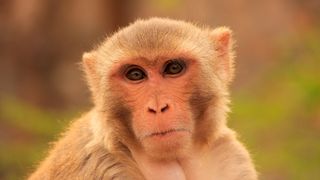
Scientists mapped the brain of an adult rhesus macaque, a type of monkey.
(Image credit: Donyanedomam via Getty Images)
Scientists have revealed an unprecedented “atlas” of a primate brain that maps the organ in greater resolution than ever before, on the scale of single cells.
The U.S.-based team used the latest molecular biological techniques to map the brain architecture of an adult rhesus macaque (Macaca mulatta), a monkey commonly used as a model to investigate human perception, cognition, aging and neurological disease. A key aim of the research is to understand the differences between the human brain and the nonhuman primate brain.
“Grasping the intricate structure of brain cells is paramount to comprehending the brain’s functioning and potential disorders,” said Michel Thiebaut de Schotten, director of research at the French National Centre for Scientific Research (CNRS) and a team leader at the Institute of Neurodegenerative Diseases, a research collaboration between CNRS and the University of Bordeaux. He was not involved in the new study.
The new research “presents an unparalleled architectural depiction of cell types in the macaque brain, marking a significant milestone for neuroscience,” de Schotten told Live Science in an email. “Moving forward, it’s vital to delve into the connections between these cells, variations across individuals, and the implications these discoveries hold for understanding the human brain.”
Related: We finally know why the brain uses so much energy
The new primate brain atlas was published Oct. 12 in the journal Science Advances.
Previous studies that aimed to map the primate brain often used a single line of analysis to characterize its many cells. For example, some used only a technique called transcriptomics, which involves looking at all of the RNA in a cell; RNA molecules help cells build proteins, among other tasks.
What distinguishes the new work is the team’s “multi-omics” approach that catalogs cells in multiple ways, including transcriptomics and “epigenomics,” which looks at chemical tags that sit on top of the cell’s DNA. These tags help control which genes are switched on or off.
Incorporating both methods on cells from 30 brain regions, the group generated a 4.2 million-cell atlas of the macaque brain. For context, the macaque brain is estimated to have more than 6 billion cells in total. The team identified 112 distinct cell types and subtypes based on this molecular data and mapped the cells’ distribution across the wrinkled cerebral cortex and in brain areas under the cortex, as well as in the cerebellum down at the bottom of the brain.
“To our knowledge, these data represent the largest and most comprehensive multimodal molecular atlas in any nonhuman primate to date,” the study authors wrote. They noted that the atlas should serve as a valuable resource for investigating the evolution of the human brain and for deepening our understanding of brain-related conditions, including degenerative diseases such as Alzheimer’s and developmental disorders such as autism spectrum disorder and attention deficit hyperactivity disorder.
The macaque brain atlas was published alongside 20 additional papers conducted as part of a years-long, international research effort spurred by the National Institutes of Health. Known as the BRAIN Initiative Cell Census Network project (BICCN), the effort is focused on mapping the human, nonhuman primate and mouse brains at a cellular level of detail.
In addition to the monkey brain atlas, BICCN-affiliated scientists collectively published a similarly detailed atlas of the human brain, which has enabled researchers to identify previously unknown brain cell subtypes.
“We see that many cell types are broadly conserved across species,” said Kimberly Siletti, a neuroscientist who was formerly at the Karolinska Institutet in Sweden and is now at the University Medical Centre Utrecht in the Netherlands. Siletti led a key component of the work on human brains.
“Now that we know the human brain is not built in an entirely different way [than monkey brains], we can use all these new data to ask more specific questions about how human cell types specialize, which makes this an exciting time for neuroscience,” Siletti told Live Science in an email.
Stay up to date on the latest science news by signing up for our Essentials newsletter.
Nicola Williams holds a PhD in the History of Science from the University of Leeds, U.K. and currently works as a science writer across an array of subject areas broadly spanning, but not limited to, biology, physics, medicine and technology. This diversity reflects a broad scientific background, a neurodiverse noggin and a passion for all things science!
>>> Read full article>>>
Copyright for syndicated content belongs to the linked Source : Live Science – https://www.livescience.com/health/neuroscience/new-atlas-of-a-monkey-brain-maps-42-million-cells
